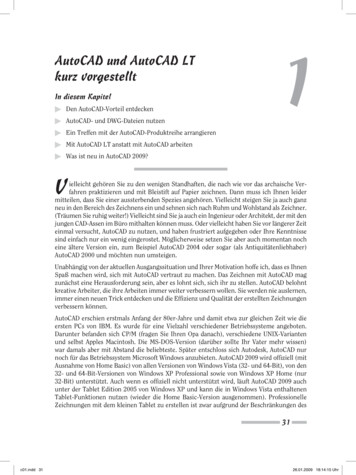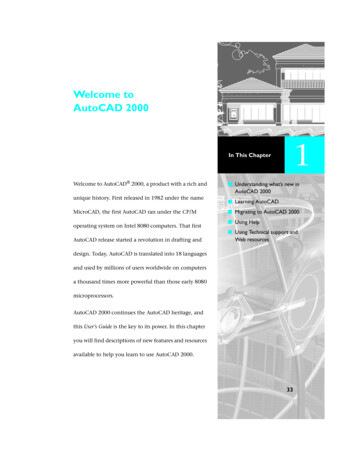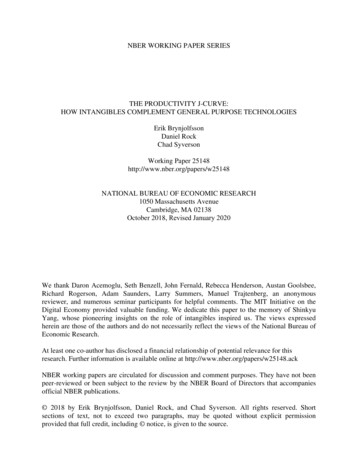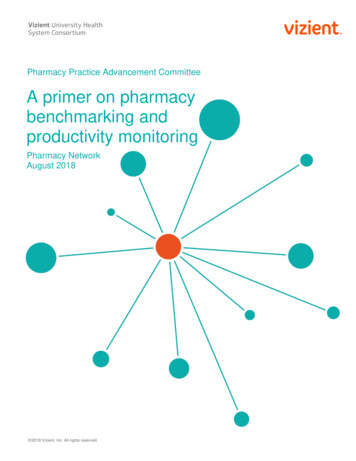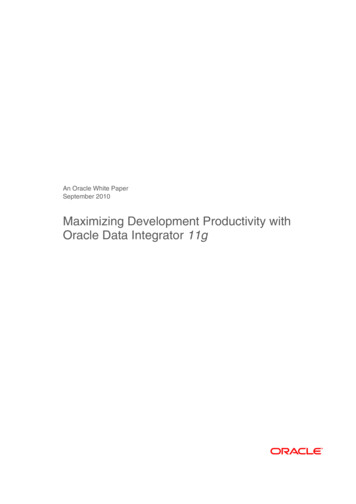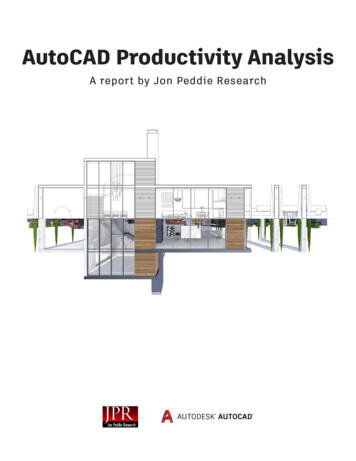
Transcription
AutoCAD Productivity AnalysisA report by Jon Peddie Research
AutoCAD Productivity AnalysisTable of ContentsExecutive Summary . 2Study Goals and Objective . 3A survey of CAD end users . 3Survey results . 4General characteristics of the respondents . 4Working with DWG files . 7The value of DWG files . 9Exchanging DWG files . 11The respondents and their organizations . 16Conclusion . 18Table of FiguresFigure 1: Geographic location of respondents . 5Figure 2: The experience of the CAD users. 6Figure 3: Almost 2/3rd of the respondents work in 3D . 7Figure 4: DWG files are clearly the most popular format . 8Figure 5: AutoCAD was used for just under half of the DWG files created . 8Figure 6: Over 31% of the respondents spend more than 40% of their time creating DWG files . 9Figure 7: The average time AutoCAD is used in a project by the respondents is 5.8 months . 10Figure 8: Forty-percent of the respondents think a completed DWG file is worth on average 28,400. 10Figure 9: Not all the DWG files the respondents get from outsiders have been created in AutoCAD. 11Figure 10: CAD users exchange DWG drawings with other companies 3/4s of the time. 12Figure 11: AutoCAD users share their drawings over half the time with other companies . 12Figure 12: DWG files from outsiders are corrupted about 30% of the time . 13Figure 13: AutoCAD files are corrupted less than 16% of the time from internal sources . 13Figure 14: The CAD user repairs corrupted files about 40% of the time . 14Figure 15: The respondents spend a little over an hour repairing a corrupted CAD drawing . 15Figure 16: DWG files are the overwhelming majority used by the respondents . 16Figure 17: Most of the respondents are in design and engineering . 17Figure 18: Size of organization . 17Figure 19: Respondent’s company’s industry segment . 18Page iCopyright 2014 Jon Peddie Research
AutoCAD Productivity AnalysisExecutive SummaryJon Peddie Research conducted a very focused survey with CAD users to gauge the value theyplace on their drawings and the challenges they encounter in an increasingly multi-CAD worldwhere CAD users may often encounter CAD drawings from a variety of CAD vendors.According to the JPR survey: Professionals in the field place the value of a DWG file at 28,400,Surveyed CAD professionals report that AutoCAD is required 43% of the time, andThey spend an average of 5.4 months on a project.In the context of this survey, sixty-eight percent of the people who use other programs work withDWG files as well. It is interesting to note that today, people tend to work with more than oneCAD software tool. According to this survey, they are using an average of 2.3 programs.The respondents spend almost one third of their time working with DWG files.AutoCAD users get damaged files from outside sources 31.4% of the time and spend at least anhour repairing them.Respondents have an average of 9.7 years’ experience, which suggests they are experienced inhandling DWG files and have developed efficient strategies for repairing damaged files.Many of the respondents worked for very large firms. The average size of the companiesrepresented in the survey was 2,386 employees. Most respondents said they are working inmanufacturing related fields, and the second most selected field was engineering.Using our own research of the CAD industry, Jon Peddie Research has found that the DWGformat is the most common format for 2D CAD drawings in the industry. One out of 4 peopleusing CAD tools are working with AutoCAD or AutoCAD LT. In all, 2 out of 5 people working inCAD are touching DWG files. We believe these estimates are conservative, but they confirm theimportance of DWG in the CAD industry.Page 2Copyright 2014 Jon Peddie Research
AutoCAD Productivity AnalysisStudy Goals and ObjectiveAutodesk engaged Jon Peddie Research (JPR) to generate a custom report with data to understandand quantify advantages and issues associated with DWG files in multi-CAD environments.Companies involved in large projects with multiple partners and subcontractors may encounterCAD drawing files from a variety of sources. Likewise, the trend towards collaboration betweenusers and companies has fostered multi-CAD environments. Several companies offer CAD tools,which promise DWG compatibility. This study asked users about their experiences in theseenvironments.The study asked how often people encountered problems with DWG files created in productsoutside the Autodesk product family. And, the survey asked how much time they worked on thosefiles in an effort to preserve data integrity.We also asked about the value associated with that intellectual property in time or data loss.All of us working on this survey were curious to discover if even slightly incompatible softwareputs the user at risk, endangering, or even causing the loss of their intellectual property by using anon- trusted data source.As part of that investigation we sought to find out how many of the participant’s projects requireAutoCAD as well as the number of professionals who use AutoCAD.This report therefor is quantitative and comparative. Whenever possible, the data is in concreteterms such as nine out of ten AEC professionals use AutoCAD, or 20% of professionals use DWGas an exchange format.Overall, we believe the survey demonstrates the importance of DWG as a repository for designdocumentation. In addition, the survey notes that users spend a significant amount of timerepairing files and are able to place a dollar figure to those files.A survey of CAD end usersJPR conducted an on-line web-based survey of CAD users. We used various end user lists and thegood offices of several friendly web sites to solicit CAD users to take the survey. The surveytargeted people who frequently visit web sites devoted to CAD, or who have asked for informationrelated to CAD products. We offered the participants raffle gifts as an incentive to take the survey.Our goal was to reach 30,000 people who are involved in the CAD industry; we reached 607,990individuals. Our hope was to get a 2-3% rate of response (on 30,000 invitations), we received2,446 a 0.4% response.Page 3Copyright 2014 Jon Peddie Research
AutoCAD Productivity AnalysisList supplierJPRAutodeskEvery MediaDesktop EngConnect 990Return1486821469974732,446% Return1.56%0.55%0.29%2.49%0.12%0.4%Of the respondents, we disqualified 72 who worked for a CAD software companies; we onlywanted users and their managers. That left us with 2,374 qualified returns.We designed the survey in conjunction with Autodesk, and Autodesk gave final approval of itbefore we launched it.The survey established the demographic profiles of participants including experience andprograms used. Because this is a survey built around software use, Autodesk was not interested inthe platforms the participants use.Survey resultsAlthough we had the survey translated into three languages, English, French, and Japanese, andthe invitations were also translated and sent to prospective email addresses, the responses fromcollected in French and Japanese were disappointing. We received just 1.36% French responsesand only 0.29% in Japanese.Of the 34 French respondents, 24 of them were disqualified for working for a CAD softwarecompany, which left us with just 7 qualified French respondents, or 0.3%, not significant.Seven Japanese people responded and four of them were disqualified leaving us with just 0.1%,also not significant.In looking through the data we found a few dozen email addresses with country specific address(e.g., .fr) and those all chose the take the survey in English.General characteristics of the respondentsThe geographical distribution of the respondents was overwhelmingly from North America, 86%,the second highest count was Western Europe with 6%.Page 4Copyright 2014 Jon Peddie Research
AutoCAD Productivity AnalysisFigure 1: Geographic location of respondentsWe were quite successful in reaching actual CAD users, and over 92% of respondents said theyuse CAD software.To make the results meaningful we also wanted to find out how long the respondents had workedat their current job, and found almost 56% of them had been working in their current job for over10 years.Page 5Copyright 2014 Jon Peddie Research
AutoCAD Productivity AnalysisFigure 2: The experience of the CAD usersWe found this question to be important because it gives considerable weight to the value andexperience to the answers of the subsequent questions; these are people who have hard-earnedexperience and their views are quite valuable.To double check the validity of the users, we asked the question even more specifically – howlong have you been using CAD, and over 77% of them answered over 10 years—this was a verypleasing result because it meant we could have a very high degree of confidence in the conclusionswe drew from their subsequent answers. Over 62% of the respondents work in 3D, which was alarger percentage than we expected, and gave us confidence that we would get valuable insightabout the importance of quality in DWG files.Page 6Copyright 2014 Jon Peddie Research
AutoCAD Productivity AnalysisFigure 3: Almost 2/3rd of the respondents work in 3DWe were fascinated to find that respondents are now working predominantly in 3D. This is a shiftthat has been a long time in coming and marks a significant milestone in CAD practices. The“Other” category was mostly people who worked in both 3D and 2D.As expected, the respondents don’t use just one CAD program, but they overwhelmingly workedwith AutoCAD. The respondents who answered the question worked with an average of 2.3programs.Working with DWG filesWe wanted to find out how widely used DWG files were. We got an interesting spread. In all, over45% of the respondents work with DWG as their primary format and only 5.6% never haveoccasion to work with the DWG format.Page 7Copyright 2014 Jon Peddie Research
AutoCAD Productivity AnalysisFigure 4: DWG files are clearly the most popular formatConversely, although most of the respondents said they worked with DWG files most of the time,there is a significant use of other formats in the respondents’ companies. This is in line with ourfindings that people are working with more than one CAD program.Figure 5: AutoCAD was used for just under half of the DWG files createdWe have established that the DWG format is a popular format in the industry.Page 8Copyright 2014 Jon Peddie Research
AutoCAD Productivity AnalysisFigure 6: Over 31% of the respondents spend more than 40% of their time creating DWG filesThe value of DWG filesTo determine the value of DWG files we asked how much time people spend on drawings andhow long their projects typically last.Page 9Copyright 2014 Jon Peddie Research
AutoCAD Productivity AnalysisFigure 7: The average time AutoCAD is used in a project by the respondents is 5.8 monthsWe asked the respondents to estimate what they thought was the value of a completed DWG fileto see if it was possible to put a value on it. Understandably, most users are not sure how to valuea completed CAD file. It may often depend on the type of work a person does and the size of theproject. However, close to 50% of the respondents were willing to put a price on their work.Figure 8: Forty-percent of the respondents think a completed DWG file is worth on average 28,400Page 10Copyright 2014 Jon Peddie Research
AutoCAD Productivity AnalysisExchanging DWG filesAutodesk's TrustedDWG technology helps identify DWG files that were not last saved byAutoCAD and informs customers that Autodesk cannot guarantee the compatibility of such DWGfiles with AutoCAD software. We asked the respondents about their experiences dealing withDWG files from other sources.Figure 9: Not all the DWG files the respondents get from outsiders have been created in AutoCADExchanging DWG files with other companies is a very common experience according to
AutoCAD users get damaged files from outside sources 31.4% of the time and spend at least an hour repairing them. Respondents have an average of 9.7 years’ experience, which suggests they are
